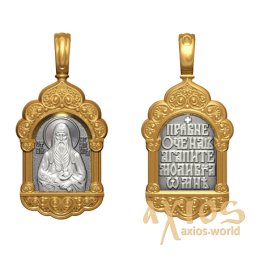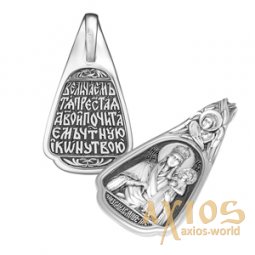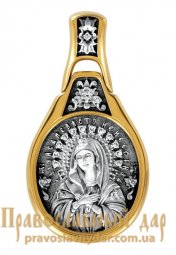Material: 925◦ silver, 999◦ gold plated
Average weight: 10.3 grams
Size: 35*22mm
Technique: casting, gilding, blackening, handmade.
Prayer: "Reverend Father Anthony, pray to the Lord for the salvation of our souls"
The Monk Anthony of the Caves is revered by the Orthodox Church as the pioneer of monasticism in Russia and the founder of the first Russian monastery - the great Kiev Peche Lavra. Rev. Anthony (in the world of Antipas) was born in 983 in the city of Lyubech not far from Chernigov. From childhood, he strove for an ascetic life, and already at the age of fourteen he went to Athos in search of a spiritual mentor. On the Holy Mountain he visited many monasteries and was tonsured at the Esfigmene Monastery. He spent several years in obedience to the elder and, having gained experience in the spiritual life, received the blessing of his mentor to return to Russia. The elder, according to a revelation from God, foresaw the special role of Anthony in the development of spiritual life in the newly baptized Russian lands and predicted that many Chernorizians would descend from him there.
Arriving in Kyiv, Anthony went around many Greek monasteries that were already there, but did not stay in any, because he did not find the strict monastic life that he was used to on Athos. In 1013, he retired to a cave on the banks of the Dnieper near the town of Berestovo. After the death of the baptist of Russia, St. equal to ap. Vladimir in Kyiv, a turmoil began, during which the sons of Vladimir, Sts. Boris and Gleb. Rev. Anthony left the turmoil for Athos, but after the victory of Yaroslav the Wise he returned and again settled in the same place. He chose a cave, which was dug for solitary prayers by the presbyter of the Berestovskaya church, Hilarion, the future Metropolitan of Kyiv. Rev. Anthony expanded this cave and began to live in it.
Rev. lived for twenty years. Anthony underground. During this time, only a few ascetics joined him, and among the first were the Monks Nikon and Theodosius. When the number of ascetics reached twelve, together they dug out new cells for themselves and built an underground church. This is how the first caves of the monastery appeared.
Under the heir of Yaroslav Izyaslav, St. Anthony became famous. The prince himself came to him with a squad for a blessing. But it was this fame that was the cause of many anxieties of the humble hermit. Twice he had to leave his cell due to princely disfavor. For the first time, Izyaslav became angry with the monk when the son of a noble boyar, blessed Varlaam, and the beloved servant of the prince, were tonsured in his monastery. Izyaslav threatened to dig out all the caves and imprison the monks.
The Monk Anthony with the brethren left the caves for other places, but was soon returned by the prince who came to his senses. On another occasion, Izyaslav suspected the Pechersk elder of treason, accusing him of being an adviser to Prince Vseslav of Polotsk, who had seized the throne in Kyiv. The monk went to Chernigov, where he founded the new St. Ilyinsky Yelets Monastery. After some time, the slander was revealed, and Izyaslav was forced to ask St. Anthony to return.
Upon the return of Rev. Anthony appointed blessed Varlaam as rector of the monks, and dug himself a new cave on another hill. But soon the monks began to settle there next to him. This is how the Near and Far Caves arose.
When Prince Izyaslav appointed Varlaam as rector of the newly equipped Dmitrievsky monastery, Anthony, at the request of the brethren, appointed St. Theodosius. The name of this great saint is associated with the introduction in Russia of a new Studian cenobitic monastic charter.
Many miracles were performed by St. Anthony, having become famous especially as a healer of mental and bodily ailments. One of the most significant miracles is the choice of a site for the construction of the Assumption Church. Through the prayer of St. Anthony, the Lord pointed him out three times, irrigating the earth with dew, or leaving it dry, and finally brought down fire from heaven and burned all the growth in the chosen place.
From the beginning of the construction of the Great Assumption Church, Anthony completely went into seclusion, where he peacefully reposed on July 10 (23), 1073 and was buried in the Near Caves. The monk bequeathed not to look for his relics, and to this day "the grace of God preserves the sacred tomb." The memory of St. Anthony is celebrated on the day of his repose and in the Cathedral of the Venerable Fathers of the Kiev Caves, in the Near Caves of the Rest, September 28 (October 11).
Icon with the icon of St. Anthony is made in the form of a square and decorated with floral ornaments. The square is an ancient symbol of the earth, flowers and shoots with leaves are the image of the “Spiritual Garden”, which the saint planted with his prayerful feat. In the hands of Rev. Anthony a scroll on which the first words of his prayer are inscribed: "Lord, let there be a blessing in this place." On the reverse side of the icon are the words of a prayer to the saint in Church Slavonic: "Our Reverend Father Anthony, pray to the Lord for the salvation of our souls."








